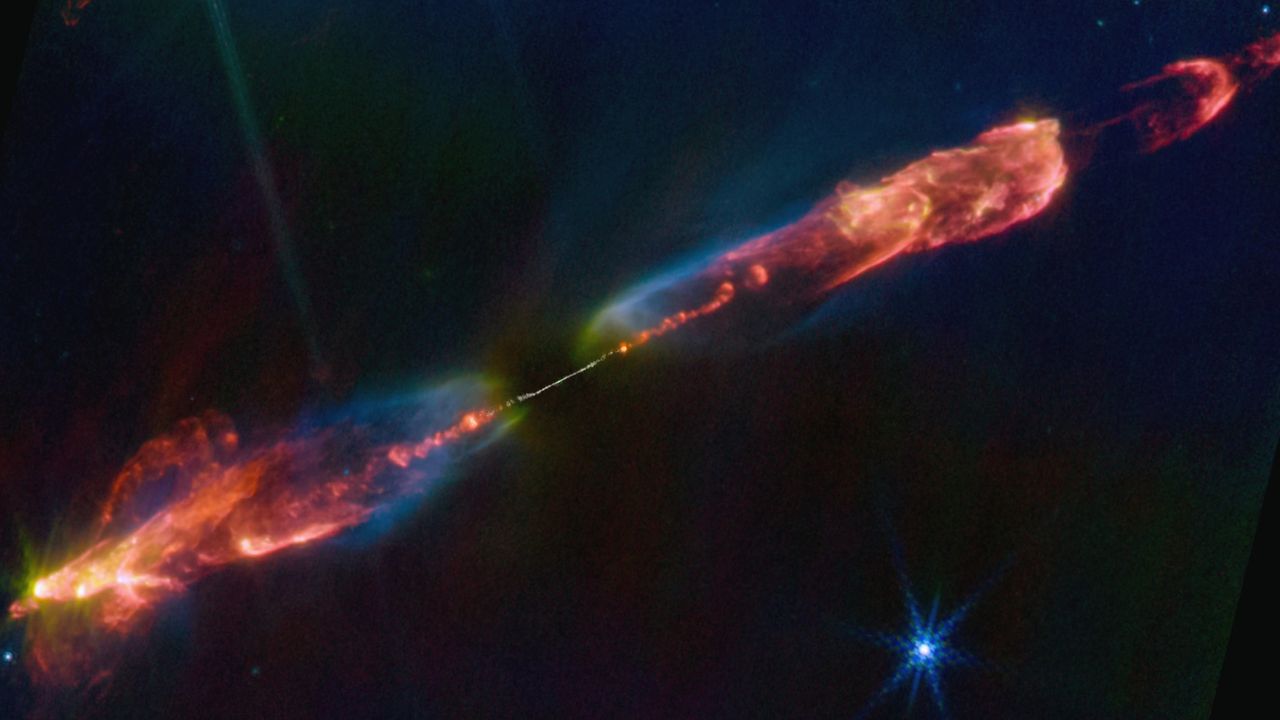Science
ALMA and JWST Uncover Secrets of Star Formation in HH 211

Astronomers have made significant strides in understanding the process of star formation by studying the protostar HH 211, located approximately 1,000 light-years from Earth in the constellation Perseus. Using data from the Atacama Large Millimeter/submillimeter Array (ALMA) and the James Webb Space Telescope (JWST), researchers were able to capture unprecedented details about this young star system, shedding light on the mechanisms behind protostellar jets.
The findings, published on August 13, 2023, in the journal Scientific Reports, reveal that HH 211 is a Herbig-Haro object, a luminous region formed by the powerful jets emitted from newborn stars. Despite being only 35,000 years old and having a central protostar with a mass of just 0.06 times that of the sun, HH 211 exhibits a bright bipolar jet, which consists of two streams of energized ionized material ejected in opposite directions.
Insights from ALMA Observations
The ALMA observations indicated that the jets travel at remarkable speeds of around 66 miles per second (or 107 kilometers per second). Interestingly, while these jets are fast-moving, they exhibit slow rotation, suggesting that they are removing excess rotational energy from the surrounding accretion disk. The researchers calculated that the jets originate from a point only 0.02 astronomical units (approximately 1.85 million miles or 3 million kilometers) from the protostar.
This study provides valuable evidence supporting the idea that magnetic fields play a critical role in the formation of protostellar jets. The magnetic field is theorized to act like a slingshot, propelling gas outward and facilitating the growth of the star by allowing material to more easily fall into it.
Combining Data for a Complete Picture
The collaboration between ALMA and JWST offered a comprehensive view of HH 211. The JWST captured stunning near-infrared images of the bipolar jet, although the dense cosmic dust surrounding the central region obscured the jet’s launch site. This was where ALMA’s capabilities came into play, providing insights in submillimeter wavelengths that revealed the crucial thin region at the center of the accretion disk.
By overlapping the data from both telescopes, researchers were able to create a detailed image of the star formation process. The grayscale image from ALMA clearly illustrates the jet being launched, marking the first time the launch site of a protostellar jet has been documented. This discovery emphasizes the importance of these jets in the star formation process, as they facilitate the removal of angular momentum from the accretion disk, allowing more material to flow toward the star.
The collaboration between these two powerful observatories not only enhances our understanding of star formation but also opens new avenues for exploring the complexities of our universe. As astronomers continue to investigate the intricate processes of star birth, discoveries like those made with HH 211 will undoubtedly contribute to a deeper comprehension of stellar evolution and the dynamics of cosmic structures.
-

 Lifestyle5 months ago
Lifestyle5 months agoLibraries Challenge Rising E-Book Costs Amid Growing Demand
-

 Sports4 months ago
Sports4 months agoTyreek Hill Responds to Tua Tagovailoa’s Comments on Team Dynamics
-

 Sports4 months ago
Sports4 months agoLiverpool Secures Agreement to Sign Young Striker Will Wright
-

 Lifestyle4 months ago
Lifestyle4 months agoSave Your Split Tomatoes: Expert Tips for Gardeners
-

 Lifestyle4 months ago
Lifestyle4 months agoPrincess Beatrice’s Daughter Athena Joins Siblings at London Parade
-

 Science4 months ago
Science4 months agoSan Francisco Hosts Unique Contest to Identify “Performative Males”
-

 World4 months ago
World4 months agoWinter Storms Lash New South Wales with Snow, Flood Risks
-

 Science5 months ago
Science5 months agoTrump Administration Moves to Repeal Key Climate Regulation
-

 Business5 months ago
Business5 months agoSoFi Technologies Shares Slip 2% Following Insider Stock Sale
-

 Science5 months ago
Science5 months agoNew Tool Reveals Link Between Horse Coat Condition and Parasites
-

 Sports4 months ago
Sports4 months agoElon Musk Sculpture Travels From Utah to Yosemite National Park
-

 Science5 months ago
Science5 months agoNew Study Confirms Humans Transported Stonehenge Bluestones









